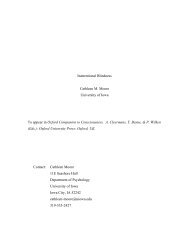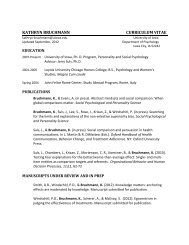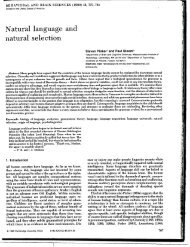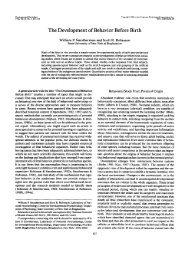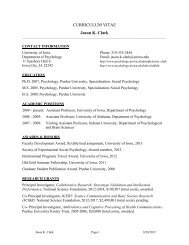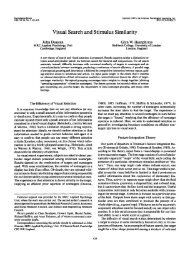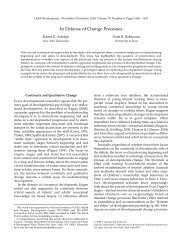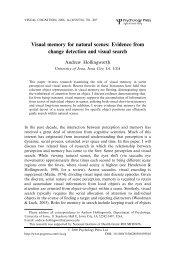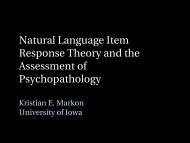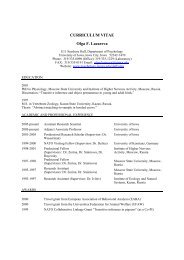Speech and language development following ... - ResearchGate
Speech and language development following ... - ResearchGate
Speech and language development following ... - ResearchGate
- No tags were found...
You also want an ePaper? Increase the reach of your titles
YUMPU automatically turns print PDFs into web optimized ePapers that Google loves.
C. Ouellet, H. Cohen / Journal of Neurolinguistics 12 (1999) 271±288 281Uziel et al. [87] demonstrated that modi®ed open-set recognition was quite evident12 months <strong>following</strong> the implantation <strong>and</strong> got even better three years later.Regardless of the percentage of success, open-set discrimination always appearspossible with multichannel implants in most children born deaf or with acquireddeafness, even in hearing-alone conditions [23]. This increased response to soundsin everyday life makes children more alert to interactions with their environment.Three months after wearing the device, children can respond to their names up to63% of the time [53].Although there is generally some improvement in speech perception until 4 or 5years post-implantation, some subjects may, on occasion, show decreased speechperception performance over time, apparently due to a cognitive regressionassociated with age [85]. As was suggested earlier, postoperative performanceappears in¯uenced by the level of preoperative linguistic abilities. In e€ect,patients possessing some preoperative open-set recognition abilities obtainedsigni®cantly higher scores on all recognition measures, at 12 months postimplantation,whereas those with no open-set speech recognition skills before theoperation improved on only half of the measures in the same post-implant period[92]. <strong>Speech</strong> identi®cation also varies according to word frequency, lexical density<strong>and</strong> word length. Lexically easy words (high frequency with few neighbors) arebetter identi®ed than more dicult words (low frequency with many neighbors);word recognition is also better for polysyllabic than monosyllabic stimuli [29].The primary role of cochlear implants is to enable speech perception. Animportant secondary role is to permit speech production <strong>and</strong> help patients acquire<strong>and</strong> produce consonant <strong>and</strong> vowel features which are dicult for individuals withprofound hearing loss (e.g. high vowels, diphthongs, alveolar consonants <strong>and</strong>fricatives [54]. Language <strong>development</strong> in implanted prelingually deaf children maybe signi®cantly faster than predictions based only on maturation of unimplantedpeers would suggest. At the 12-month postoperative interval, expressive <strong>language</strong>scores have been shown to be higher than the corresponding scores predictedbased on non-operated peers Ð this e€ect was not seen at the 6-month interval.Although implanted children were delayed compared to normal-hearing subjectsat each interval tested, their rate of <strong>language</strong> growth matched that of hearingcontrols. The gains made by implanted children in expressive <strong>language</strong> weresimilar to those expected from hearing children <strong>and</strong> superior to those expectedfrom unimplanted deaf children, at each testing interval from 6 months to 2.5years after implantation. There is, however, signi®cant inter-subject variability inlinguistic abilities <strong>following</strong> the operation, with some patients reaching nearnormal<strong>language</strong> levels, whereas others remain delayed <strong>and</strong> show a wide gapbetween linguistic age <strong>and</strong> chronological age [47].Implant users may exceed their preoperative performance for both intelligibility<strong>and</strong> articulation, after experience with a device for from 1 to 4.5 years. Theseimprovements occur for front, middle <strong>and</strong> back consonants, for stops, fricatives<strong>and</strong> glides <strong>and</strong> for voiceless <strong>and</strong> voiced consonants [16]. The intelligibility ofprelingually deaf children's speech may increase steadily over time, becomingsigni®cantly better than the preoperative performance level after only 6 months.



